The Acute Care Medical Waste Cheat Sheet
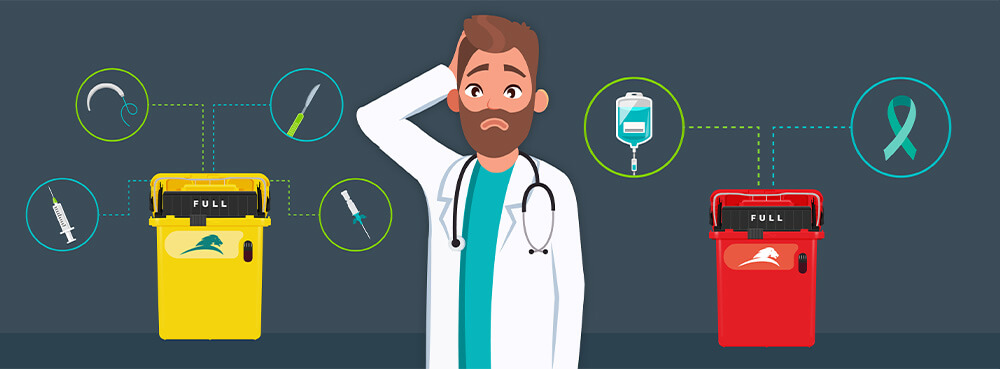
As a healthcare professional, you probably provide crucial services to patients in a busy environment. That means you rarely have the extra time to research and make certain that each piece of waste gets where it needs to be. With that in mind, here’s a quick handy reference guide, so you can, at a glance, know where waste needs to go. The number one rule to keep in mind? Send the right waste to the right bin. Keeping a properly segregated waste stream promotes both compliance and safety—the two top goals of any waste management plan.
So, let’s break down the major kinds of waste:
Most kinds of waste you’ll find in a medical facility will fit into these categories—they encompass every major disposable. Now, let’s take a look at each category and how to dispose of it.
Blood Waste
This is perhaps the largest category of sensitive waste a medical facility will deal with. It includes the kind of waste you’d usually think of when you imagine medical waste, such as blood-contaminated items and human secretions. Here is a list of some common forms of blood waste.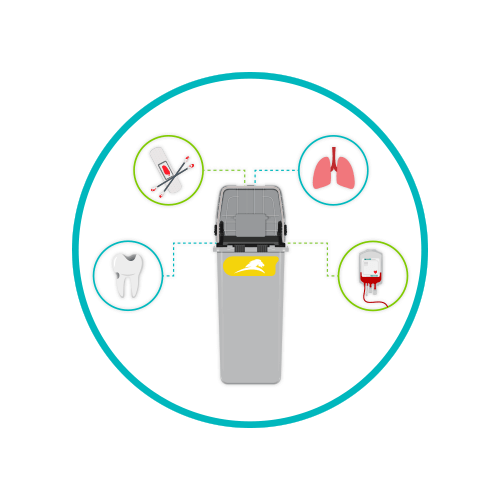
- Any item saturated with blood. For example: gauze, bandages, gloves, tubing, etc.
- Securely closed disposable sharps containers
- Body fluids visibly containing blood
- Body fluids removed in the course of surgery, treatment, or necropsy
- Human blood and blood products, including serum, plasma, and platelets
- Dialysis filters and tubing that visibly contain blood
- Cultures or stocks of any virus, bacterium, or other organism, including discarded live attenuated vaccines and the items used to transfer, inoculate or mix cultures
- Items that have come into contact with bloodborne pathogens. Any amount of blood infected with HIV, Hepatitis, Malaria, etc. is treated as blood waste, even if it's not saturated.
Sharps Waste
Sharps are a very common sight in patient care and medical facilities, and used sharps must be disposed of carefully to prevent infections as well as sharps injuries. These sharps can be glass, metal, or plastic items with rigid corners, sharp edges, or protruding pieces that can slice, scrape or pierce the skin. Common examples of sharps include:
- Acupuncture needles
-
Blood vials
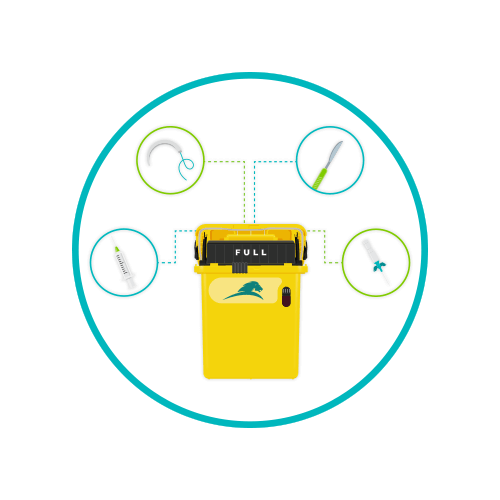
- Broken glass or capillary tubes
- Laboratory slides
- Exposed ends of dental wires
- Lancets
- Needles
- Pipettes
- Root canal files
- Scalpel blades
- Suture needles
- Scissors
- Trocars
- IV bag spikes
- Any items capabale of causing punctures or cuts
Note that chemo-contaminated sharps belong in a separate category.
What should a good sharps container look like? It should have a smart design that prevents hand-access and removes the risk of bounce or rollback. It should also be designed to efficiently stack sharps to minimise the frequency of full containers. Finally, it should be leak-proof, tamper-proof, and not allow for over-filling. Daniels’ line of Sharpsmart containers check all of these boxes and more when it comes to safety and ease of use.
Pharmaceutical Waste
What kinds of medications usually go into the pharmaceutical waste stream? 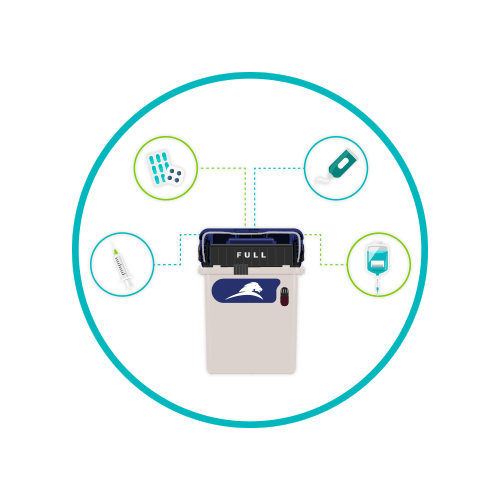
- All Syringes, Containers, or IV Bags with Residual Medication that have not been administered directly to the patient
- Pills
- Broken Ampoules and Vials
- Ointments and Creams
-
Solid or Liquid Oral Doses
Most importantly, remember that cytotoxic drugs and narcotics that haven’t been denatured do not belong in this waste stream. However, once a narcotic has been suitably denatured, it may be added.
Cytotoxic or Chemotherapy Waste
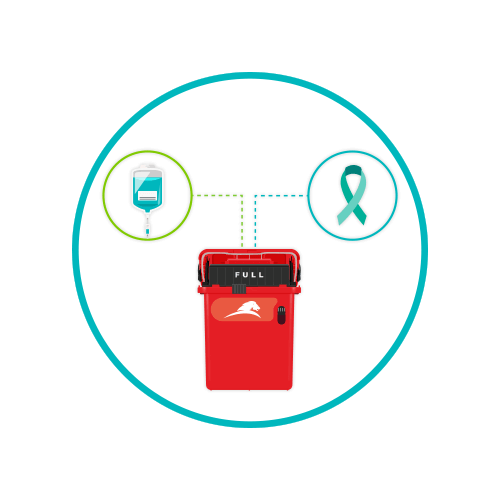
Not all medical facilities will deal with waste generated by chemotherapy, but for those that do, it is very sensitive and requires specific handling. In Canada, medical practitioners must separate cytotoxic sharps from non-sharp cytotoxic waste. Cytotoxic sharps waste can be disposed of in a reusable container, while single-use containers must be used for non-sharp cytotoxic waste.
Cytotoxic Sharps Waste
- Needles/syringes used to administer cytotoxic medication
- Vials that contained cytotoxic medication
- Any other items capable of causing punctures or cuts that have come in contact with cytotoxic medication
The above wastes can go into a red sharps container.
Other Cytotoxic Waste
- Cytotoxic drugs and packaging
- Any items (other than sharps) that have come in contact with cytotoxic medication (e.g., IV bags, tubing, gloves, gowns, etc.)
- Bodily fluids of patients receiving cytotoxic medication within the previous 48 hours (e.g., urine, feces, vomit, etc.)
Wastes in the "other cytotoxic waste" category must be disposed of into a red pail or a cardboard box with a red liner.
Anatomical Waste
Anatomical waste is defined as:
- Human tissue, organs, and body parts (not including teeth, hair, or nails)
- Animal tissue, organs, body parts, and carcasses (not including teeth, fur, feathers, or nails)
This waste is disposed of in a red pail, a blue drum, or a cardboard box with a red liner.
General Waste
Never waste space in specialised medical waste containers and increase disposal costs by misplacing trash that could go into the general waste stream. Contrary to popular belief, most wastes contaminated with bodily fluids are not generally considered to be regulated medical waste, including clothing, rags, and other materials contaminated with sweat, vomit, urine, and faeces. Additionally, here are some other common items that could be mistaken for medical waste but usually do not require special disposal unless they have been contaminated in some way: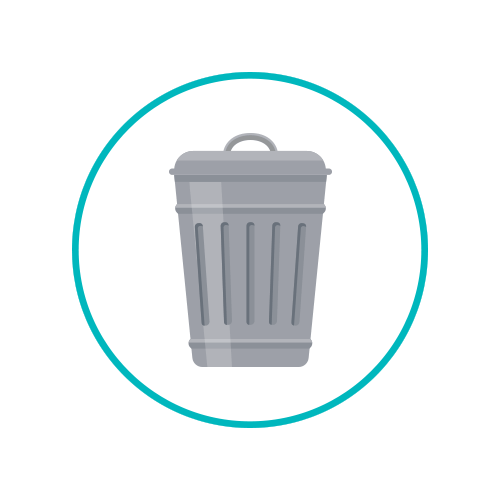
- PPE
- Packaging
- Personal Hygiene Products
- Paper Towels
- Unmedicated IV bags and tubing
- Food and Organic Materials
- Recyclables
Need More Assistance With Your Medical Waste Collection, Segregation, and Disposal?
Hopefully, this guide helps clarify the major must-knows of medical waste disposal. A well segregated waste stream and a knowledgeable staff are key components of a great waste management strategy that can keep a facility safe and compliant. Daniels helps facilities across Canada devise and implement the right waste management strategy to fill their unique needs. With products ranging from reusable biomedical waste containers to Sharpsmart intelligent design, there is a product that’s designed with the realities of healthcare environments in mind, for every category of medical waste. Reach out to learn about Daniels cost-effective cradle-to-grave solutions for acute care facilities throughout Canada.
